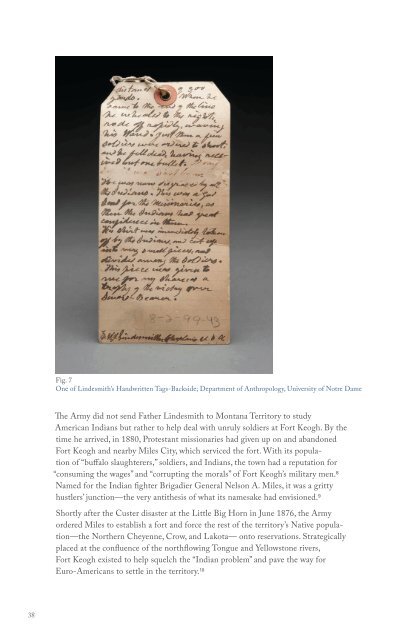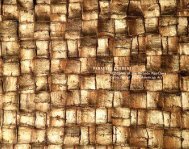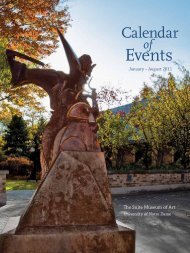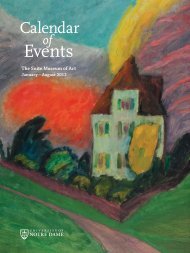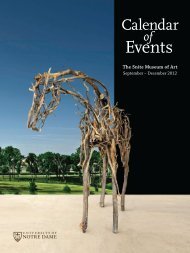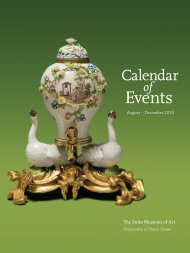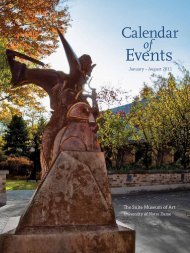HISTORY INTO ART AND ANTHROPOLOGY - Snite Museum of Art ...
HISTORY INTO ART AND ANTHROPOLOGY - Snite Museum of Art ...
HISTORY INTO ART AND ANTHROPOLOGY - Snite Museum of Art ...
Create successful ePaper yourself
Turn your PDF publications into a flip-book with our unique Google optimized e-Paper software.
Fig. 7<br />
One <strong>of</strong> Lindesmith’s Handwritten Tags-Backside; Department <strong>of</strong> Anthropology, University <strong>of</strong> Notre Dame<br />
The Army did not send Father Lindesmith to Montana Territory to study<br />
American Indians but rather to help deal with unruly soldiers at Fort Keogh. By the<br />
time he arrived, in 1880, Protestant missionaries had given up on and abandoned<br />
Fort Keogh and nearby Miles City, which serviced the fort. With its population<br />
<strong>of</strong> “buffalo slaughterers,” soldiers, and Indians, the town had a reputation for<br />
“consuming the wages” and “corrupting the morals” <strong>of</strong> Fort Keogh’s military men. 8<br />
Named for the Indian fighter Brigadier General Nelson A. Miles, it was a gritty<br />
hustlers’ junction—the very antithesis <strong>of</strong> what its namesake had envisioned. 9<br />
Shortly after the Custer disaster at the Little Big Horn in June 1876, the Army<br />
ordered Miles to establish a fort and force the rest <strong>of</strong> the territory’s Native population—the<br />
Northern Cheyenne, Crow, and Lakota— onto reservations. Strategically<br />
placed at the confluence <strong>of</strong> the northflowing Tongue and Yellowstone rivers,<br />
Fort Keogh existed to help squelch the “Indian problem” and pave the way for<br />
Euro-Americans to settle in the territory. 10<br />
By 1880, Protestant missionaries believed that the residents<br />
<strong>of</strong> Miles City and soldiers <strong>of</strong> Fort Keogh had lost their moral<br />
compass. A visiting missionary reported that the fifteen people<br />
who attended one Sunday service did so in a room above a<br />
carpenter’s shop, surrounded by c<strong>of</strong>fins, sitting atop sawhorses,<br />
and in the company <strong>of</strong> stray dogs that were devouring scraps<br />
<strong>of</strong> food. “At the same hour,” he continued, “there were probably<br />
more than three hundred men congregated in the bar-room and<br />
gambling halls.” 11 It was clear, at least to this missionary, that<br />
the new fort and town were fostering a population <strong>of</strong> unabashed<br />
heathens.<br />
On the face <strong>of</strong> it, sending the fifty-three-year-old Father<br />
Lindesmith to Montana would not seem to indicate the Army<br />
thought it had chosen someone who could deal effectively with<br />
Fort Keogh’s morality problem. On two prior occasions—<br />
during the Mexican-American War and Civil War—the Army<br />
had turned Lindesmith away. The Montana commission was<br />
not one for the faint <strong>of</strong> heart. In 1880 the national military<br />
was downsizing, the socalled Indian wars were highly controversial,<br />
and relations with the Northern Cheyenne, Crow, and<br />
especially the Lakota were notoriously volatile. Furthermore,<br />
relations among these native groups were strained, exacerbated<br />
by increased land dispossession and by the intertribal warfare<br />
<strong>of</strong> Indian scouts who worked cooperatively, and for pay, with<br />
the Army.<br />
Many Euro-Americans who fought in the West’s Indian wars<br />
were first-generation immigrants from countries such as France,<br />
Germany, Ireland, Italy, and Poland. The fact that 40 percent <strong>of</strong><br />
Fort Keogh’s enlisted men were Catholics helped prompt the<br />
Army to commission Father Lindesmith to be its first peacetime<br />
Catholic chaplain. 12<br />
Lindesmith came from a long line <strong>of</strong> Ohio natives who had<br />
served in the military, first in the Revolutionary War and later<br />
in the War <strong>of</strong> 1812. But for reasons never fully explained, the<br />
Army rejected Lindesmith’s <strong>of</strong>fers to serve in the Mexican-<br />
American War and the Civil War. (He apparently was so<br />
lastingly affected by these earlier rejections that he tried—<br />
unsuccessfully, after his time in Montana—to procure an Indian<br />
War Badge for his service in a campaign against the Sioux. 13 )<br />
Lindesmith lost his father when he was seven years old, an event<br />
followed by traumatizing experiences <strong>of</strong> abandonment and<br />
servitude. He was thirteen when his mother remarried, and she<br />
and her new husband forced the adolescent to live and labor on<br />
a neighboring farm for three years.<br />
Fig. 6<br />
Officer’s Dress Sword, SMA, UND<br />
38 2012.026.002<br />
39


